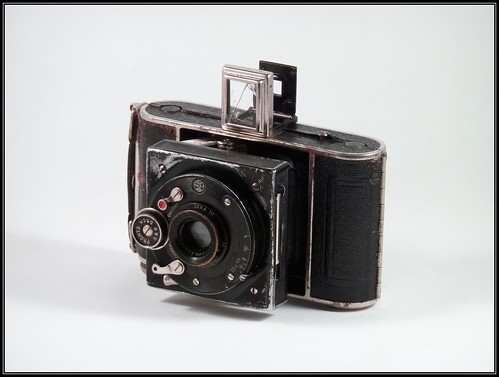Difference between revisions of "Piccochic"
Hanskerensky (talk | contribs) (/photos/99085049@N05/20920882670 added from pool) |
m (Updated LPA link) |
||
| (2 intermediate revisions by 2 users not shown) | |||
| Line 1: | Line 1: | ||
| + | <div class="floatright plainlinks" style="margin:0px 0px 10px 15px;"> | ||
{{Flickr_image | {{Flickr_image | ||
|image_source= http://www.flickr.com/photos/99085049@N05/20920882670/in/pool-camerawiki/ | |image_source= http://www.flickr.com/photos/99085049@N05/20920882670/in/pool-camerawiki/ | ||
| Line 7: | Line 8: | ||
|image_rights= with permission | |image_rights= with permission | ||
}} | }} | ||
| − | The '''Piccochic''' is a strut-folding camera for 3x4 cm pictures on [[127 film]], made by [[Balda]] in Dresden, in about 1930. It is rather similar to the [[Korelle 3x4]] by [[Kochmann]],<ref name=W>[ | + | </div> |
| + | The '''Piccochic''' is a strut-folding camera for 3x4 cm pictures on [[127 film]], made by [[Balda]] in Dresden, in about 1930. It is rather similar to the [[Korelle 3x4]] by [[Kochmann]],<ref name=W>[https://www.leitz-auction.com/en/Kochmann-Korelle/AI-21-13693 Piccochic], incorrectly identified as a Kochmann Korelle, with Meyer 5 cm f/2.7 Makro-Plasmat, Compur shutter with speeds to 1/300 second, and studs to attach an accessory rangefinder; offered but not sold at the [https://www.leitz-auction.com/en/Cameras/Past-Auctions/Auction-21/ 21st Westlicht Photographica Auction], on 23 May 2012.</ref> or the 3x4 [[Dolly (3×4)|Dolly]] by [[Certo]]. | ||
Like many folding cameras of the 1930s, it was available with a wide range of 5 cm lenses, from moderately-priced f/4.5 triplets including a Radionar or Trioplan, to an f/3.5 Tessar, f/2.9 Xenar or f/2.7 Makro-Plasmat (by [[Meyer]]).<ref name=W/> McKeown even refers to an Elmar.<ref name=McK>{{McKeown12}} p106.</ref> A similarly wide range of shutters was available, from [[Vario]] to [[Compur-Rapid]]. | Like many folding cameras of the 1930s, it was available with a wide range of 5 cm lenses, from moderately-priced f/4.5 triplets including a Radionar or Trioplan, to an f/3.5 Tessar, f/2.9 Xenar or f/2.7 Makro-Plasmat (by [[Meyer]]).<ref name=W/> McKeown even refers to an Elmar.<ref name=McK>{{McKeown12}} p106.</ref> A similarly wide range of shutters was available, from [[Vario]] to [[Compur-Rapid]]. | ||
| − | Some examples have front-element focusing; others have helical focusing with a focus lever moving through a short arc on the lens board. The cited example at Westlicht, with one of the best available lenses, has studs next to the viewfinder to attach an accessory rangefinder; the two examples pictured by McKeown lack these.<ref name=W/><ref name=McK | + | Some examples have front-element focusing; others have helical focusing with a focus lever moving through a short arc on the lens board. The cited example at Westlicht, with one of the best available lenses, has studs next to the viewfinder to attach an accessory rangefinder; the two examples pictured by McKeown lack these.<ref name=W/><ref name=McK/> |
There is a folding frame finder, which erects itself when the lens is pulled out to unfold the camera. The camera has a tripod bush, and a folding table stand attached to the shutter unit, that allows it to stand on a level surface for horizontal pictures. | There is a folding frame finder, which erects itself when the lens is pulled out to unfold the camera. The camera has a tripod bush, and a folding table stand attached to the shutter unit, that allows it to stand on a level surface for horizontal pictures. | ||
| − | The Piccochic was re-badged by [[Birnbaum]] as the '''Embirella''', and by Photo-Schaja as the '''Schaja-Fix'''.<ref name=McK | + | The Piccochic was re-badged by [[Birnbaum]] as the '''Embirella''', and by Photo-Schaja as the '''Schaja-Fix'''.<ref name=McK/> |
| Line 26: | Line 28: | ||
[[Category: 127 film]] | [[Category: 127 film]] | ||
[[Category: 1930]] | [[Category: 1930]] | ||
| + | [[Category: P]] | ||
Latest revision as of 17:38, 23 January 2024

|
| Balda Piccochic image by bratieres (Image rights) |
The Piccochic is a strut-folding camera for 3x4 cm pictures on 127 film, made by Balda in Dresden, in about 1930. It is rather similar to the Korelle 3x4 by Kochmann,[1] or the 3x4 Dolly by Certo.
Like many folding cameras of the 1930s, it was available with a wide range of 5 cm lenses, from moderately-priced f/4.5 triplets including a Radionar or Trioplan, to an f/3.5 Tessar, f/2.9 Xenar or f/2.7 Makro-Plasmat (by Meyer).[1] McKeown even refers to an Elmar.[2] A similarly wide range of shutters was available, from Vario to Compur-Rapid.
Some examples have front-element focusing; others have helical focusing with a focus lever moving through a short arc on the lens board. The cited example at Westlicht, with one of the best available lenses, has studs next to the viewfinder to attach an accessory rangefinder; the two examples pictured by McKeown lack these.[1][2]
There is a folding frame finder, which erects itself when the lens is pulled out to unfold the camera. The camera has a tripod bush, and a folding table stand attached to the shutter unit, that allows it to stand on a level surface for horizontal pictures.
The Piccochic was re-badged by Birnbaum as the Embirella, and by Photo-Schaja as the Schaja-Fix.[2]
Notes
- ↑ 1.0 1.1 1.2 Piccochic, incorrectly identified as a Kochmann Korelle, with Meyer 5 cm f/2.7 Makro-Plasmat, Compur shutter with speeds to 1/300 second, and studs to attach an accessory rangefinder; offered but not sold at the 21st Westlicht Photographica Auction, on 23 May 2012.
- ↑ 2.0 2.1 2.2 McKeown, James M. and Joan C. McKeown's Price Guide to Antique and Classic Cameras, 12th Edition, 2005-2006. USA, Centennial Photo Service, 2004. ISBN 0-931838-40-1 (hardcover). ISBN 0-931838-41-X (softcover). p106.